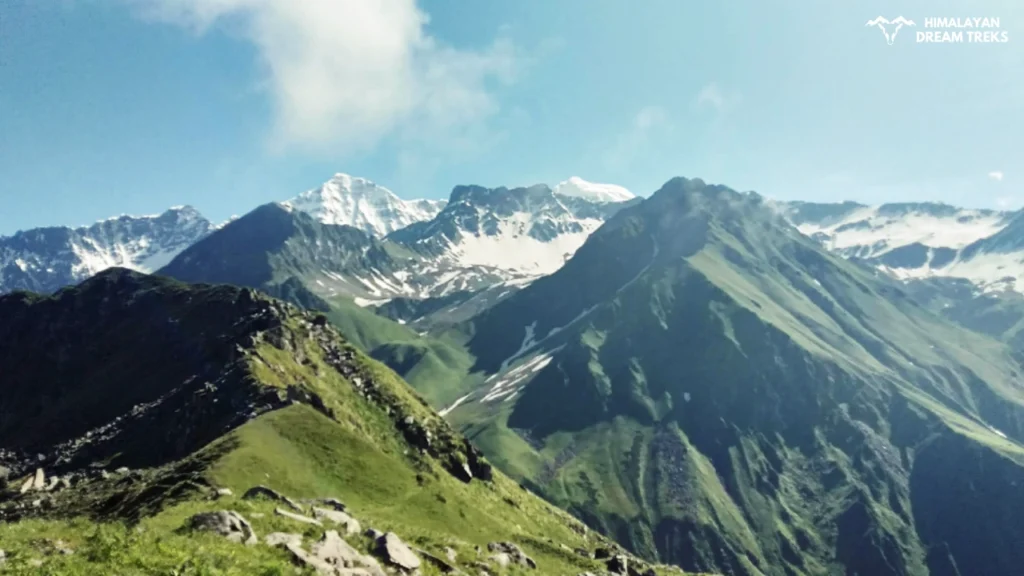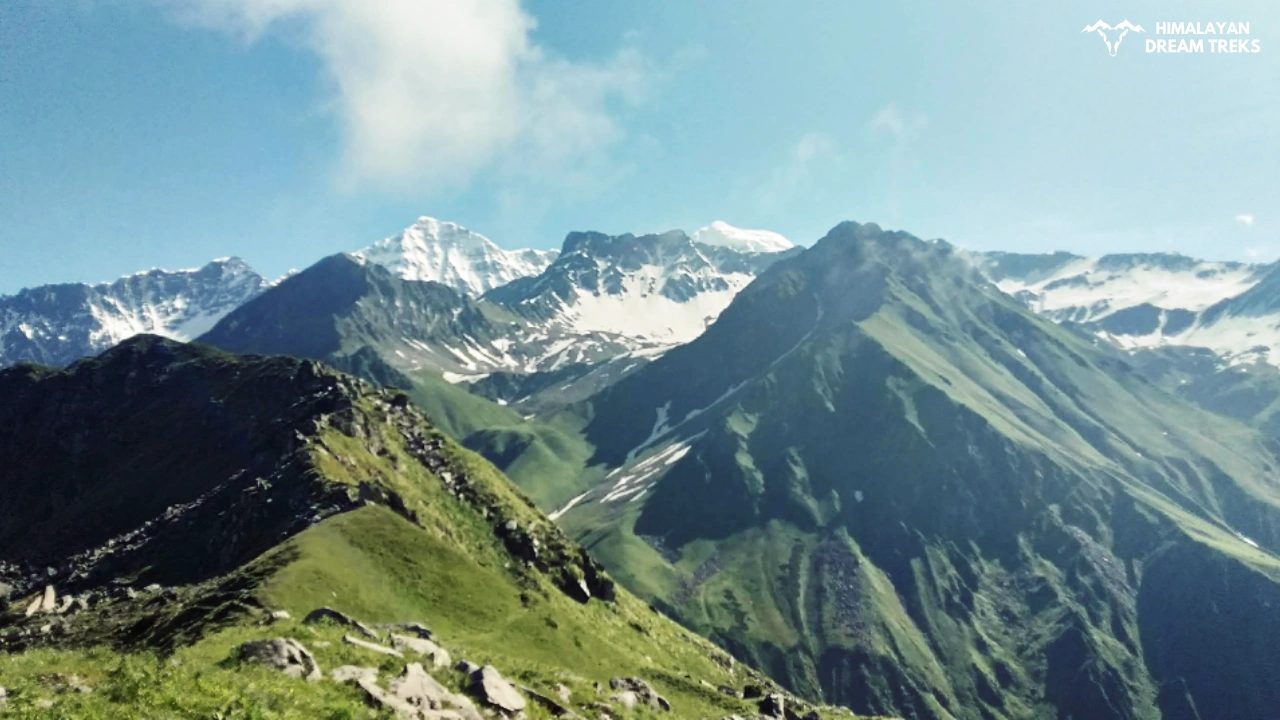Hidden in the serene landscapes of Uttarkashi, Uttarakhand, the Gulabi Kantha Trek is a Himalayan jewel that beautifully balances adventure with tranquility. Unlike its more popular counterparts, this trail remains relatively offbeat, offering visitors untouched meadows, cultural warmth, and sweeping mountain views. For those seeking nature’s calm without the rush of crowds, Gulabi Kantha is a perfect choice—whether you are a first-time trekker or an experienced explorer.

The Trek at a Glance
The Gulabi Kantha Trek is graded as easy-to-moderate and generally takes 5 days to complete. Starting from the quaint settlement of Hanuman Chatti, the trail gradually ascends to 4,023 meters (13,200 feet). This altitude strikes a balance: approachable for beginners while still carrying the thrill and grandeur of a high-altitude Himalayan journey.
Its nickname, “The Pink Meadow, (Gulabi=Pink and Kantha=Bugyal/Meadows)” comes from the burst of colors it showcases in late spring when rhododendrons and other wildflowers cover the alpine meadows (bugyals). During this season, the entire landscape is painted in gentle shades of pinks and purples against the backdrop of snow-clad peaks.
The route winds through oak, maple, and rhododendron forests, passes humble Garhwali villages such as Nishni, and eventually opens into the wide stretches of Seema Thatch meadow—an idyllic campsite that feels straight out of a storybook.
For trek packages, group dates, and a detailed itinerary, you can learn more on the official Gulabi Kantha Trek page.
Reasons That Make Gulabi Kantha Trek a Must-Visit Himalayan Gem
The Best High Altitude Experience for First Timers
The trek reaches a perfect height of about 13,200 feet; however, it is approachable with an easy-to-moderate level of difficulty. The summit of Gulabi Kantha reveals a panoramic spectacle, including Bandarpunch, Kedarkantha, Black Peak, Draupadi ka Danda, Baukh Tibba, Jonali Peak, and several unnamed mountain peaks. Unlike crowded trails, where vistas may feel fleeting, here the mountains seem closer and more personal. The deep valleys and surrounding bugyal regions add to the experience of a perfect Himalayan trek. In winter, the snow-covered peaks grab attention, but in spring and early summer, it becomes even more special when pink rhododendrons bloom, showcasing its nickname—Gulabi Kantha.
Gentle Summit Approach with Easy-Moderate Difficulty
Trekking on trails above 12,000 feet may feel uncomfortable for many trekkers, especially beginners and families. However, in the past, we have seen many families with kids enjoy the charm of this trek. This is due to the gradual path and proper acclimatization. The highest point is not a steep summit but more of a gentle ridge, offering panoramic views of Himalayan peaks and deep valleys on both sides. The trail to the top is a gentle zig-zag path, which reduces the incline compared to a direct ascent. Acclimatization happens naturally on this trek, as our itineraries are carefully planned to give enough time for the body to adjust to the environment.
Meadows and Blooming Flora
Each season gives the trek a unique personality, making it rewarding year-round. In spring and summer, the bugyals are fragrant with wildflowers, lush green meadows, and blooming rhododendrons. Many bird species can be spotted, and nature looks especially vibrant during this time. Cool mountain air, breathtaking views, and the greenery make it a perfect summer trekking experience. In winter, the region is blanketed in snow, turning it into an ideal spot for skiing. While many hill destinations become inaccessible due to harsh terrain, places like Gulabi Kantha offer a rare opportunity to enjoy fresh snowfall and stunning snowscapes.
Peace and Solitude:
Today, many famous treks are struggling to retain their natural peace due to heavy crowds, but Gulabi Kantha’s trail still enjoys its silent and calm nature. Forests, grasslands, and trekking routes are all less crowded on this trek. Gulabi Kantha offers a calm trekking experience, ideal for thoughtful travelers, photographers, or anyone seeking quiet reflection in nature. The serene environment is truly unforgettable, especially in winter, when the whistling wind blends with the dazzling snow-covered landscape, creating a magical Himalayan experience.
Sunsets Above the Clouds
Every Himalayan summit offers stunning sunsets, but Gulabi Kantha has a charm of its own. Here, sunsets often bathe the mountains in glowing shades of orange, pink, and lavender. Trekkers describe standing above the floating clouds, watching this spectacle, as one of the most magical moments of the journey.
Pure Religious Vibes
Easy access to Yamunotri and other nearby temples allows you to experience strong religious vibes. The region is considered spiritually powerful, and it is said that Neem Karoli Baba ji used to visit and reside here from time to time. If you embark on the trek when the Yamunotri Dham is open, it is a perfect opportunity to participate in the Darshan and other rituals at the temple. Along the trek, Nishni village also has a temple dedicated to its local deity, built in the traditional style. The purity of the area is reflected in local beliefs, such as not leaving unwashed utensils overnight, as it is thought the deity becomes displeased.
Gulabi Kantha Trek: A Clearer Perspective
When it comes to getting a true perspective of a new trek, the best way is to compare it with a well known trek, considering factors like experience, altitude, best time to visit, difficulty, and other features. Here is a comparison with a trek in the same easy-to-moderate category: Kedarkantha. Both Gulabi Kantha and Kedarkantha are beginner-friendly Himalayan treks in Uttarakhand. They share similarities, such as snow-clad beauty in winter, sweeping vistas, and rich forest trails, but their personalities differ in ways that matter to trekkers.
| Aspect | Kedarkantha | Gulabi Kantha |
|---|---|---|
| Location | Uttarkashi | Uttarkashi |
| Base Camp | Sankri Village | Hanuman Chatti |
| Altitude | 12,500 ft | 13,200 ft |
| Trek Distance | ~20 km | ~28 km |
| Duration | 5 days | 5 days |
| Grade | Easy to Moderate | Easy to Moderate |
| Popularity | Very popular and busy | Offbeat and less crowded |
| Highlights | Sunrise, thrilling summit climb, Juda ka Talab, village interactions | Sunset views, expansive wildflower meadows, closer peaks, proximity to Yamunotri Dham |
Why Gulabi Kantha Stands Out
- Higher and Gentle Summit Approach: Kedarkantha reaches 12,500 feet, while Gulabi Kantha rises higher at 13,200 feet. Despite the greater altitude, the climb is more gradual and forgiving, making it especially suitable for first-time trekkers.
- Closer Himalayan Views: Towering mountains like Bandarpunch appear almost within touching distance, which is not always visible from Kedarkantha.
- Fairytale Meadows: Bugyals draped in wildflowers during summer or covered with snow in winter create dreamlike landscapes. Gulabi Kantha has vast meadow regions and also provides views of nearby bugyals, which are often even more captivating than those around Kedarkantha.
- Peace and Solitude: Unlike the busier Kedarkantha route, Gulabi Kantha offers a calm, crowd-free trekking experience. Today, while Kedarkantha attracts large groups, Gulabi Kantha still maintains its silent and peaceful nature—an experience no trekker would want to miss.
- Pure Religious Vibes: The region lies within Yamunotri Valley, one of the Char Dham pilgrimages of Uttarakhand. Villages like Nishni still practice age-old traditions, such as keeping no dirty utensils unwashed at night, as locals believe it would anger their deity. Such cultural nuances add a sacred purity to the trek.
Conclusion
If your heart leans toward tranquility, sunsets, and lesser-traveled paths, Gulabi Kantha feels like a personal conversation with the mountains. Its blend of ease, beauty, and cultural depth makes it a rewarding choice for beginner trekkers, seasoned hikers, and nature lovers alike.
For seekers of peace, color-drenched bugyals, and moments of stillness under the setting sun, Gulabi Kantha is truly a trekking destination in Uttarakhand that deserves a top place on your trekking list.

Leave a Comment